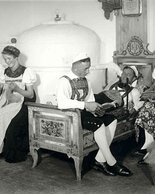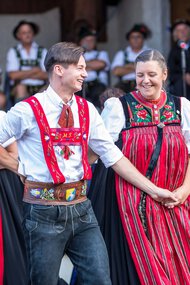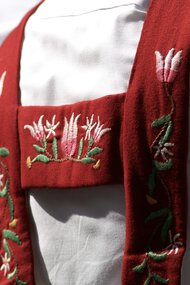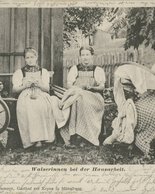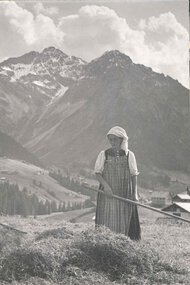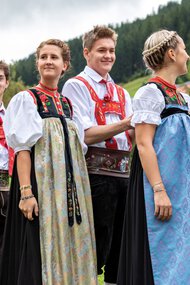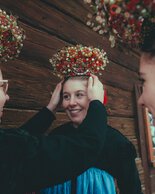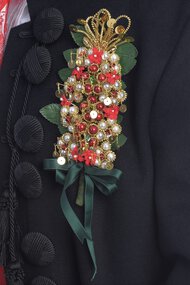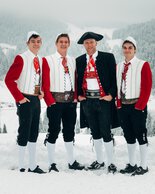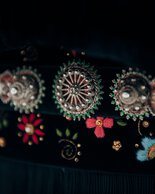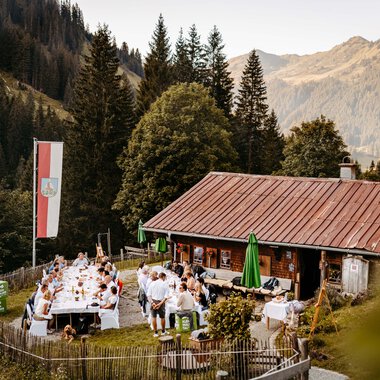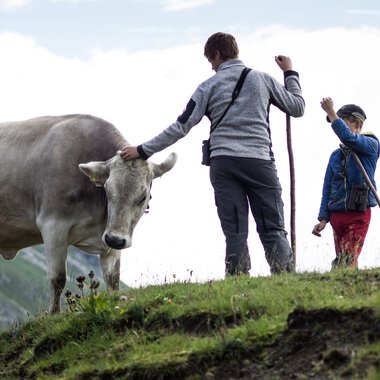Timelessly beautiful: the traditional Walser costume
05.07.2023
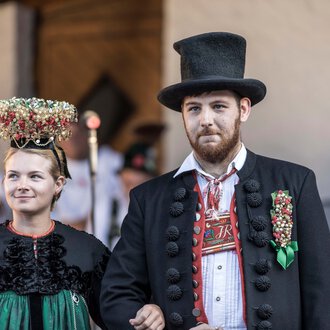
On Friday, the mountains once again reveal their special magic: Alpine magic. As the last rays of sunshine transform the Kleinwalsertal sky into a brilliant play of colors, the peaks glow in a soft orange hue. Down in the valley, young dancers in festive costumes whirl across a stage accompanied by traditional folk music. It quickly becomes apparent that the colorful fabrics, belts and jewelry are not dirndls and lederhosen. The members of the Kleinwalsertal traditional costume group wear traditional Walser costume.
the costume is a feeling.
"What's so special about traditional costume?" I ask Jasmin Riezler and Theresia Fritz, chairwomen of the Kleinwalsertal traditional costume group. Most of us have certainly worn a dirndl or lederhosen for a visit to the Oktoberfest or the Wasen at some point.
"Everyone wears a dirndl and it looks nice, but for me it's always something fashionable. Something that can change every year." says Theresia. The traditional costume, on the other hand, is timeless. And it has a special historical and personal background. "You don't just buy a traditional costume off the peg," adds Jasmin. It is inherited or given as a gift. Painstakingly put together piece by piece. It quickly becomes clear: not all traditional costumes are the same. One is not better or worse than the other. They are simply two different things. Traditional costume care and traditional costume fashion.
Woven history
Many of the fabrics that float across the stage at Alpenzauber are very old - passed down from great-grandparents through the generations. They have seen and experienced how Kleinwalsertal has developed from an agricultural valley into a popular vacation destination. Nowadays it is not easy or very expensive to obtain the materials. Some things, such as the coral necklaces, can no longer be bought. Most items are lovingly restored and appreciated anew. In this way, the traditional costume is also interwoven with the identity of the valley, its inhabitants and ancestors.
"It's not just a change of clothes, but a ritual that you slip into... I got the Juppa from my great-grandmother, who I never got to meet myself. (...) Every time I put it on, I think to myself: amazing! The Juppa has danced and celebrated at so many weddings, birthdays and parties. It's more the historical thing you slip into. And it does something to you!" -Theresia
Steeped in history. In the truest sense of the word.
How did the costume come about in the first place? This is where it gets a little more difficult. Because there are few to no records. The traditional costume of the local Walser people is one of the oldest in Vorarlberg. However, its exact date of origin cannot be determined. However, it is certain that it was worn by men in everyday life until around 1870 and by women until 1890. The traditional costume was then gradually replaced by more modern and probably more practical clothing.
Because when you look at the magnificent traditional costumes, the question quickly arises: Did people work in them? Was it practical? The traditional costume that can be admired at Alpine Magic and sometimes at festive events in Kleinwalsertal is a festive costume. Decorated for special occasions. It looked somewhat different when working in the fields. For practical reasons, women's costumes used to be cut a little shorter, for example. Or the petticoat was used. In any case, Jasmin and Theresia are glad that they don't wear traditional costume in everyday life these days: “It's too cold in winter and too hot in summer,” laughs Jasmin. So they prefer a T-shirt and shorts.
The right way to wear it
In Kleinwalsertal they say that wearing a traditional costume means you are "ghöörig aaglaid". In other words, you are properly dressed for festive and traditional occasions. Jasmin and Theresia also like to wear the traditional costume to weddings. Sometimes it's easier than buying or choosing a dress. However, a glance at the long list of possible garments for women, children and men raises suspicions: It's not that simple after all. At least for outsiders.
The Walser women's costume
The basic outfit of the women's costume includes a white blouse, a green petticoat or underdress, with the upper visible part decorated with rose embroidery. The juppa with pleats and flounce, as well as an apron. White or black stockings and low buckled shoes are worn with it.
For dancing or casual occasions, it is worn "gschnürt" - i.e. without headgear. A "Huat" or "Chappa" (cap) is also worn by women and men at parties. The elaborately crafted crown, the "Chrans", is reserved for single women and the bride.
THE WALSER MEN'S COSTUME
The men's basic outfit includes a white shirt and black knee breeches made of velvet, cloth or leather. The suspenders are black, brown or red and decorated with colorful silk embroidery. The wide belts made of black cloth or leather often have quill embroidery or metal rivets. White stockings, black buckled shoes and a red silk neck tie, the "Mäschle", are also part of the traditional costume.
Trendy in THE COSTUME
"If we only followed tradition, we would still be living in caves, if we only followed progress, this would soon be the case again." says the website of the Kleinwalsertal traditional costume group. A healthy balance between preserving traditions and moving with the times. Development is important and cannot be stopped. And that is exactly what the Kleinwalsertal traditional costume group is all about. The members are young. Most of them are in their 20s. Is traditional costume changing as a result? The cultural asset "Walser Häß" not so much. Because "it is important to us that what we have now, this heritage, is preserved." Nevertheless, traditional costumes have always adapted to fashion and people and will continue to do so. Thanks to the traditional costume group, we can prevent even more knowledge about the history of this traditional clothing from being lost and keep the Walser traditional costume alive.
... and sometimes even your own great-grandmother surprises you, when it was always said "only subtle colors and nothing bright, nothing flashy. And then you look in your great-grandmother's wardrobe and find a Fürsches (apron) in bright orange."
Learn more about the diversity of traditional Walser costumes
You can find photos and further information about the traditional costume and its individual parts on the website of the Kleinwalsertal traditional costume group. Or you can simply visit the Walser Alpine magic and experience the traditional costume live and in color: Under Events you will find the annual Alpenzauber events that take place in summer.

